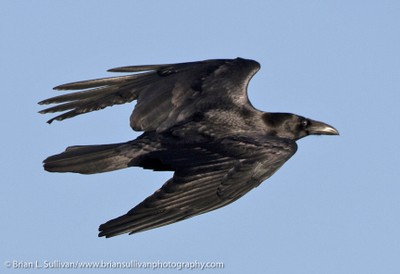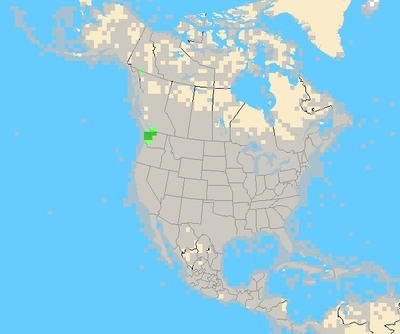Crows and ravens are widespread and abundant birds across much of North America, and most birders are familiar with the relatively ubiquitous American Crow. It might surprise you, though, to learn that the ‘black corvids’ are among the most frequently misidentified birds in eBird! This is in part due to the fact that they share essentially all-black plumages, and many birders just assume they are seeing a ‘raven’ or an ‘crow’ instead of actually taking the time to properly identify the bird to species. Successful identification of this group of birds relies on a combination of voice, range, habitat, and behavior– and there are some very subtle plumage differences, too! Next time you encounter one of these birds (likely the next time you go outside), take a minute and consider the points made in this article, and make sure you’re making an accurate and informed identification.
The Basics–Crows vs. Ravens
For many birders, the first order of business is figuring out whether you’re looking at a raven or a crow. I know, this sounds like basic stuff right, but many people get this wrong, especially when traveling to new areas and carrying their own biases with them about what should be ‘common’ or ‘rare’. There are many areas where ravens are rare, and likewise there are some areas where crows don’t occur. Always remember to look at the bird first, and make your identification based on what you see, instead of what you assume.
Ravens are larger than crows, with larger, thicker bills, stronger legs, longer, wedge-shaped tails, and more tapered, longer wingtips. In the air, they are more raptor-like, soaring for extended periods, unlike crows. They are often seen in pairs, and sometimes in large flocks (100+), but rarely occur in flocks of thousands like crows. Ravens have deeper, hoarser voices, and their characteristic call is a deep ‘rok!’ or ‘rok-rok-rok!’.
American Crow, Pt. Pinos, CA, Oct. Crows are smaller and slimmer overall than ravens, with smaller bills and thinner legs. Photograph by Brian Sullivan.
American Crow, Pt. Pinos, CA, Feb. Crows are smaller-billed than ravens, and lack the elongated, shaggy, glossy neck feathers of ravens. Photograph by Brian Sullivan.
Common Raven, Pescadero Creek, CA, Jan. Note the large, heavy bill, and glossy pointed neck feathers. Photograph by Brian Sullivan.
American Crow, Carmel Valley, CA, Feb. In flight, crows have shorter, rounder wings than ravens, and shorter squarish tails; fan-shaped when spread. Photograph by Brian Sullivan.
Common Ravens in flight, Hollister, CA, Dec. Ravens are longer-winged than crows, with longer, more swept-back ‘hands’. Ravens’ tails are longer too, and ofter appear rounded or wedge-shaped. Photographs by Brian Sullivan.
What to look (and listen) for
Voice
Given that these species are essentially all-black, it should come as no surprise to birders that voice plays an important role in identification. Luckily, these species have quite distinctive voices, but there are some things to be cautious about. Typical individuals are often readily identified by their calls (listen to some examples below). Beware, however, that juveniles of all species have higher-pitched voices than adults, at least for the first 1-2 months after fledging. At this time of year, be wary of making out of range identifications of Fish Crow based solely on voice!
Typical Calls
American Crow calls are deep and throaty. Beware of higher-pitched juveniles in late summer. American Crow voices vary regionally (higher-pitched along the West Coast), and the Macaulay Library is a good resource for exploring that variation.
Fish Crow calls are higher-pitched and more nasal than American Crow, and often doubled to create a nasal ‘uh-oh’.
Northwestern Crow calls are generally deeper and hoarser than American Crow, but there is much overlap. Perhaps not safely identified by voice alone, but see ‘Range’ below.
Tamaulipas Crow is very different, with its toad-like modulated croaking.
Common Raven calls are deep and throaty, and the classic ‘rok!’ call is distinctive.
Chihuahuan Raven‘s calls are higher-pitched and less ‘throaty’ than analogous calls of Common Raven, but beware of juvenile Common Ravens that have higher-pitched voices for the first few months after fledging.
Range
In many places, only two of these species occur together. American Crow and Common Raven is a frequent combination, as is American Crow and Fish Crow. There are very few places where one has to worry about identifying three of these species together. Looking at the maps below, you’ll note that these species’ ranges fit together almost like puzzle pieces, and knowing where you are can quickly help limit your choices about which species to consider.
American Crow is widespread and common throughout most of North America. It is replaced by Northwestern Crow from Puget Sound northward along the Pacific Coast to southeast Alaska (see below). It overlaps only marginally with that species in Washington and British Columbia, and here many crows are best left unidentified to species, and instead better recorded as “American/Northwestern Crow”. American Crow overlaps broadly with Fish Crow in the Southeast and along the East Coast, and here observers should focus on voice and behavior to distinguish the two. American Crows like broken habitat with scattered trees, and they are sometimes absent from expanses of contiguous forest, high elevation, and desert.
American Crow year-round distribution.
Fish Crow is widespread and common along the Atlantic and Gulf Coasts, and is recently spreading inland along major river systems and larger lakes. Where it occurs with American Crow, Fish Crow is often found in more suburban settings, poking around garbage dumpsters, in parking lots, fishing piers etc. American Crow is ‘wilder’ where the two species occur together, favoring more rural areas, and it is generally less approachable than Fish Crow. Fish Crows are slightly smaller, slimmer, and longer-tailed, and have more tapered wingtips than American Crow, but these differences are subtle and require comparative experience to be helpful. Voice is the best clue for distinguishing the two species!
Fish Crow breeding distribution.
Northwestern Crow is restricted to the coastal Pacific Northwest, overlapping only marginally with American Crow. Best identified by range, this species is an ongoing matter of debate among taxonomists. Northwestern Crows are very similar to coastal American Crows, and some authorities consider them to be the same species. More study is needed to determine the true taxonomic relationships among American Crow subspecies, and to learn how Northwestern Crow fits into the mix. Best tip: identify this one based on range alone, and if you’re in the overlap zone, just be conservative and record the bird as ‘American/Northwestern Crow’!
Northwestern Crow year-round distribution.
American/Northwestern Crow overlap zone.
Tamaulipas Crow is restricted to extreme southeast Texas in the United States, and even there it does not occur every year. The few recent reports come from residential Brownsville in the vicinity of the airport, but this species is essentially unknown elsewhere in Texas. If you’re not in Brownsville, you’re not seeing this species (unless of course you’re in Tamaulipas, Mexico!).
Tamaulipas Crow year-round range.
Common Raven is widespread west of the Rockies, but absent from the Great Plains and across much of the East, restricted to mostly montane areas in the eastern parts of its range. It is also a boreal forest breeder, occurring widely across the North. The range below gives and accurate picture of its year-round occurrence, but beware of local-scale differences. Along the California coast, for example, Common Ravens are common on some stretches, and largely absent from others. Always check local sources before assuming this species to be common, because while it is truly widespread, it is inexplicably absent from some places. Common Ravens are hardy birds, occupying the coldest and wildest habitats on the continent.
Common Raven year-round range.
Chihuahuan Raven is a species of dry Southwest grasslands occupying lower elevation habitats in places where it overlaps with Common Raven. Chihuahuan Raven also occurs at dumps, and in towns where trash is readily available. The two raven species should be distinguished with care in areas of range overlap, and when you’re unsure (which will be often!) it’s best to record birds as ‘raven sp.’. Voice can be a good clue for distinguishing these species, with Chihuahuans having higher-pitched calls on average. Chihuahuans also have longer nasal bristles (feathers coming down across the culmen), creating a slightly shorter-billed look. The oft-quoted white-based neck feathers of Chihuahuan can be hard to see, but this can be a good field mark if the wind is blowing the right way! Common Ravens should have silvery-gray feather bases.
Chihuahuan Raven year-round range.
The Message
The take home message here is that the ‘black corvids’ are frequently misidentified by birders, and eBirders should take care to ensure that they are accurately reporting these species. When in doubt, simply use ‘crow sp.’, ‘raven sp.’, or even ‘crow/raven sp.’. There is no shame in this! But in most places you only have to distinguish between two species, so take a moment and learn what species are nearby, and especially learn their voices–the most helpful tool for identifying this group. With a knowledge of voice and range, most of these birds should be rather easily identified.
Good birding!
Team eBird














